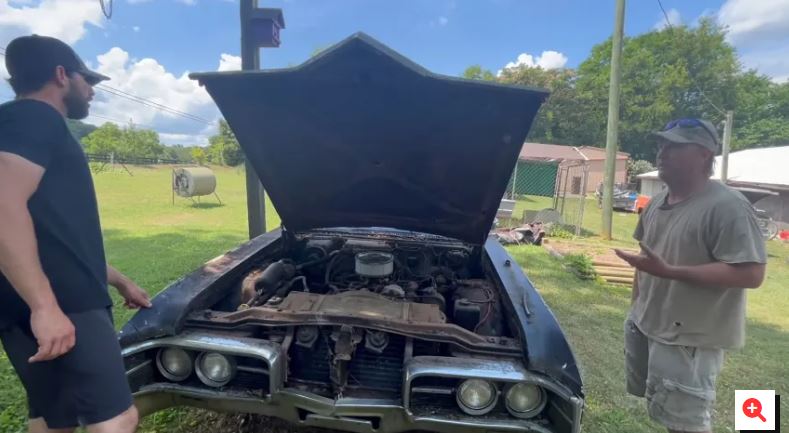It all began in 1964. Or not – it may have been 15 years before when the muscle car concept was first released. History will never set things straight for as long as there are wheels spinning on the ground, but one thing is certain: pairing a big engine with a smaller body was not a Pontiac invention. They were just the first to capitalize on an idea that Oldsmobile debuted in 1949, with the ‘88.’
The Oldsmobile 88 came around as a mongrel between a small A-frame used in the low-entry ‘76’ and a 303 cubic-inch Rocket V8 borrowed from the top-tier ‘98’ model. The five-liter over-head valve engine was a stout powerplant that quickly became the name to beat in NASCAR’s first three seasons. The Olds 88 won 36 out of 69 races between 1949 and 1951.
The nameplate lasted for a full half-century and underwent numerous variations, from the simple two-digit designator to a bunch of D-words: Delta, Dynamic, Delmont, DeLuxe, Jetstar, Super, Eighty Eight (spelled with letters instead of numbers). In the ten-generation lifespan of the nameplate, the Delmont was a two-year moniker (1967-1968), making a meteoric appearance in the middle of the sixth iteration of the long-lived model.
The full-size entry-level proposal phased out the Jetstar 88 and Dynamic 88, slated under the Delta 88 and Delta 88 Custom within the family, including the 98 and the Toronado (the last personal luxury rig). With a two-year display in the Oldsmobile line-up, it’s perfectly understandable why not too many Delmonts are now around.
The production numbers weren’t generous, to begin with, particularly in a market where the Impala was killing it as far as the full-size car segment was considered (together with other Chevys, to be honest). In 1967, the Delmont 88 garnered 78,167 units, with the popular choice veering toward the 425-cubic-inch (7.0-liter) version.
The standard motor offered was a 330-cube Jetfire Rocket V8 (5.4-liter) that was a little undersized for the bulky 4,000-lb automobile (1.8 tons). It delivered 260 hp and 355 lb-ft (264 PS, 481 Nm). Interestingly, on regular gasoline, a no-cost downgrade of the same engine produced ten fewer horsepower (250 hp / 254 PS) and twenty fewer pound-feet of torque (335 lb-ft / 454 Nm).
Overall, the Delmont offered four body styles – two- and four-door hardtops, a four-door post sedan, and a convertible – the former available only in combination with the stout 425 big-cube Starfire or Super Rocket V8s. With the big eight-banger engine, the buyer’s favorites were the more-doors (with or without a B-pillar), scoring above 21,500 units in the 1967 production roster.
The two-door Holiday Coupe (hardtop in Oldsmobilese) was ordered by 16,669 customers—not enough to call it mainstream, but not few enough to make it a coveted collectible today. Still, it has its fan base, and a two-year streak of availability makes it an interesting find for classic car rescuers.
If you are in the market for one, you might want to check out this not-so-pretty example found in Tennessee by the YouTubers from Backyard Barn Finds. The owner has several rust buckets on his property, some of them for sale (a Chevy K10 square body, a 1952 Ford F-1 pickup, a Chevrolet Caballero, and a Triumph Spitfire). Still, the Delmont is definitely the oddball in his collection.
Allegedly, it still has the original powertrain inside, but its peeling paint is not original—in fact, the shedding of its outer black skin reveals traces of the factory-applied white coat. What’s this Delmont trying to prove here, that it wants to go back, even after going black? The car was pulled out of a California boneyard by a rescuer more than a dozen years ago, and it was still running and driving at the time.
There’s no hiding that it didn’t have the nicest of lives, but Oldsmobile did its best to offer a solid car to its customers. The body was coated with two layers of paint on the underside – probably the main reason the Delmont is still a solid car. There is a sizeable puncture in the body at the top of the passenger’s side A-pillar, where the roof has succumbed to the elements. Also, the rear window is having its best days lying in the back seat of the car.
The current owner – who bought it from a friend who got it from the rescuer – drove it daily until a while ago and even had the honorable intention of fixing it. For reasons known to him only, he changed his mind and scrapped that idea (but kept the car), hoping a prospect might come up with the right amount of money.
This car has a three-speed automatic transmission, and because it is a big-block 425, the rear gearing is a 2.93:1 ratio. The 330-cube motor mandated a 2.78 axle, the lowest numerical diff of the four offered in the full-size line-up. The other two weren’t much over the top, with a 3.08 and a 3.21 ratio, respectively (the former provided solely on the Toronado).
Although it is rough and in dire need of help, this ’67 Oldsmobile Delmont 88 holds its own well. It could be turned in

